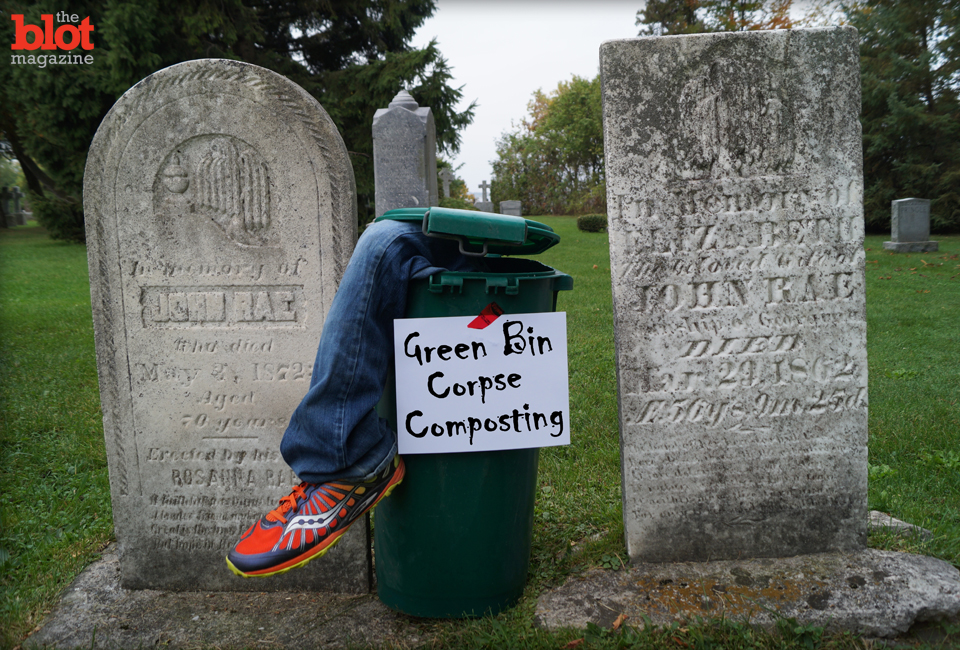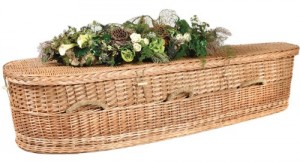I was in a cab whose alignment was so askew it crawled sideways down the road like a crab and inched past bodies burning at an outdoor crematorium next to our resort’s front gate. Welcome to Club Fiji.
I recognized the same corpses smoldering on cement slabs from one day to the next. It dawned on me that it takes a lot of energy to burn a person; we’re about 65 percent water. A traditional cremation in North America requires several hours of incineration at a heat of around 1,800 degrees Fahrenheit (heat derived from burning fossil fuels). Under current methods of incineration, cremations are not considered green and many eco cemeteries will not accept ashes. Burning bodies on the side of the road may seem macabre here in North America, but we have odd burial practices, too — take a moment to ponder embalming (pumping a corpse full of toxins for preservation) or burying a body in a metal casket built to last a millennium. What are we, ancient Egyptians?
I’ve always wanted my remains to be dumped in a field for coyotes and vultures to consume. That seems like the quickest way to return to feeding the planet and being part of life again. Sadly, that’s not exactly legal here yet, however, one can legally be consumed by crabs.
Four Burials Better for the Environment Than Embalming, Entombing in Concrete, Encasing in Steel or Cremating:
A Tisket a Tasket Get a Wicker Casket Attention Amazon shoppers: You can purchase your eco casket online with a click and a credit card. These coffins are biodegradable and sourced from sustainable materials. The Natural Green Casket (just $549), a simple hardwood box, is described as “elegant” and “perfect for natural burials, cremations, and Jewish funerals.” There are no customer reviews. The Bamboo Lattice Coffin ($1,080) looks as pretty as a picnic hamper but comes with a maximum weight capacity of 330 pounds (you probably wouldn’t want the bottom dropping out of that basket at your solemn occasion).
Crab Dip Burial at sea was something that I’d never have considered previously due to watching “CSI: Miami” and “Dexter” and envisioning myself lingering below the surface, a puffy, partially decomposed corpse. However, after contacting Dr. Gail S. Anderson (co-director at the Centre for Forensic Research and professor of criminology at Simon Fraser University in Burnaby, B.C., as well as a specialist with the American Board of Forensic Entomology), I’m almost sold on feeding the fishes. According to Dr. Anderson, who uses pig carcasses to study rates of decomposition underwater, “In the Strait of Georgia, the carcasses were skeletonized by amphipods — ‘sea lice’ — within three to 10 days depending on depth and season.” She explained that “the length of time the soft tissues remain is very variable and is very much ruled by oxygen levels. Temperature will also impact this, but my studies have so far been at around 9 C.” Dr. Anderson also explained that, “Inside a casket will be a whole different ball game. If access is restricted, it will take much longer as maceration will just be bacterial.” She added that if holes were put in the casket and “if the holes are large enough to allow access to amphipods, then it will be a bit faster, but not nearly as rapid as if [the corpses] are exposed or just in a shroud. Crabs and shrimp would not have access, and they greatly accelerate tissue removal.” New England Burials at Sea offers full-body burials at sea up and down the U.S. coast from Maine to Miami, so if you wanted to decompose fast or slow, you could select your spot based upon oxygen and water temperatures. I might select somewhere that would mean I’d shortly be eaten by a crab destined for someone’s pot in the Hamptons.
Natural Burials Natural burials are a way of burying someone that doesn’t deter decomposition. This is getting back to the earth. Graves are often more shallow, chemicals aren’t allowed, and the shroud or box needs to be biodegradable. There are different degrees to how green natural burials are. The Green Burial Council is a non-profit organization that lists a variety of more environmentally sound providers. However, those green burials don’t include being dumped in a field for vultures, but one could donate one’s corpse to a body farm or an outdoor crime lab for forensic anthropologists and scientists to study. There are a handful of body farms in the U.S.; here’s information from the University of Tennessee on donating your remains for study and a nice natural decomposition: Body Donation FAQs.
Two Methods for Composting Corpses Method 1: When I first heard about corpse composting, my visuals were far worse than the reality. I imagined stinking bodies piled high in gigantic green bins, but the method developed for corpse composting is far cleaner. A quick dip in liquid nitrogen freezes the remains, sound waves then shatter them to powder, they’re then dried out by a vacuum and finally, the dust is sieved to remove metal such as mercury from dental fillings. The remaining dust is buried shallow in the top layers of dirt. This method was developed in Sweden but hasn’t caught on in North America yet, although there is interest. Method 2: Body liquification (alkaline hydrolysis, also called bio cremation) is available in the U.S. Yes, you could be turned into sludge and composted if you wish. The Mayo Clinic uses this method to dispose of donated remains.
The closest I can come to my green burial death wish is donating my body to a body farm. This isn’t very appealing, so the alternative for me is not to die, ever. Surely someone is working on that.
Kirsten Koza is a contributing journalist for TheBlot Magazine and an author and humorist.








